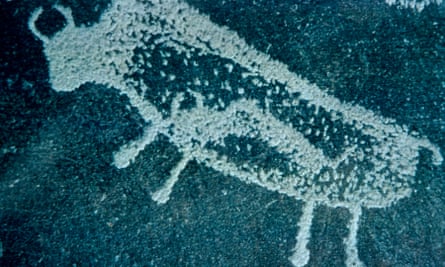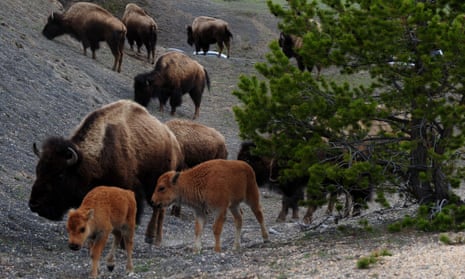It’s still morning, a slight chill in the air. You feel the rumbling of the earth before you even see the mass of bison pounding across the prairie toward the precipice, and toward you. As you stand beside the rock cairn, boughs of sage or juniper in your hands, and in the hands of your friends flanking you on either side, and across the way, you see the others draped in wolf skins, who lured the animals to this final moment. Your comrade starts the yelling just a moment before the bison reach you, and you join in, urging them towards the edge, reminding the beasts not to turn, before they thunder past, hurtling into the arroyo.
Below there are more people, to finish off the bison who survived the fall, and to start separating the useful from the non-useful, and hauling it nearby where even more people are waiting to butcher the sections properly.
By day’s end meat is smoking, pemmican is made, laughter and chatter is dying down with the setting of the sun, everyone exhausted from the work, knowing there is more tomorrow, but content. There is buffalo meat for the winter.

For thousands of years the Native peoples of North America thrived on the great plains, a landscape that is often perceived to be desolate and barren. A key subsistence practice was communal hunting of the large game that existed there - bison, but also bighorn sheep, muledeer, pronghorn, and elk. These communal hunts left behind some of the most romanticised archaeological site types, immense bison bone beds, looming cliffs, and incredible game drive systems.
Of all these sites, bison jumps or kill sites are among the most graphically tangible sites that give the public clues to a prehistoric past. The most famous is Head-Smashed-In, a World Heritage Site in Alberta Canada (pro-tip - you can visit!). Bison jumps are fascinating, in part for the amount of preparation that it required. Far from events where crazy people just stampeded a herd of panicked bison over a cliff, immense, often permanent, drives were created of rock cairns, and huge groups of people helped to guide the beasts over days through the funnel the cairns created. These drives, and the jump sites themselves, were sometimes re-used year after year. Head-Smashed-In is estimated to have been used regularly for 6,000 years.
These jumps could produce the “rivers of bones,” such as that found at the Olsen-Chubbuck site in eastern Colorado. These dense layers of bones have provided archaeologists with a wealth of information about the bison themselves, as well as ecological information about how and when people hunted them. The current consensus is that, due to fat content, pregnant females were preferred, with hunts being held in the fall after a long summer of grazing, and after the end of the rut. Tools found in these beds include projectile points, but also hafted tools such as knives, and scrapers.
The Fincastle Site in Alberta, Canada, which is not only a kill site but also a butchering site, revealed eight “ceremonial features.” While the old joke is that everything unexplainable is “ceremonial” to an archaeologist, these features consisted of metacarpals (front “hand” or hoof), scapulae (shoulder blades), and mandibles (lower jaws), all elements that wouldn’t produce much meat, vertically placed in sterile clay deposits where there wasn’t much else in the way of material goods. One of these features was composed of an “upright tibia and four mandibles positioned so the teeth fanned outward.” Bubel described these sculptures as pristine, noting that there was no evidence they were used as anvils or some other physically functional purpose. And while she didn’t hazard a guess as to what these sculptures may mean, another archaeologist, Oetelaar, has made a tidy argument for larger cosmological significance of bison procurement activities to the Native Americans who practiced them.
Oetelaar, focusing on Alberta Canada and Montana, US, illustrates how taking into account the cosmology of the Black Foot Tribe gives a different insight into how the Black Foot and their ancestors chose to propagate this economic source- he proposes that the groups in the northern plains actively planted grasses and used low-intensity fires to create a landscape that was more inviting to the Bison, and allowing humans to coerce the animals into being where the humans wanted them to be. This is dramatically different, and offers a rich, more nuanced picture than one where the Blackfoot and others responded to the environment in much the same way as the bison they hunted. Oetelaar offers the potential where more people were making more interesting choices about their world.
Whether one buys into the ecology-heavy explanations or the more active human agents theories, almost everyone seems to agree that these bison kill events would have been the place to be 2,000+ years ago. The bison kills, and the subsequent days spent processing the carcasses, creating food stores to last through what must have always been a lean winter, were social events. An opportunity for small groups of people to come together, creating a larger network of family and friends, perhaps an opportunity to find a mate, a chance to brag to old rivals, a time to mourn those who did not make it to the jump this year. And while bison and bison kills are uniquely Western American, it is probably a scene that almost any person would recognise. Rituals of life and death, surrounded by your people, immersed in food.
Further reading
- Jack Brink (2008) “Imagining Head-Smashed-In: Aboriginal Buffalo Hunting on the Northern Plains” Athabaska University Press
- Oetelaar (2014) “Better Homes and Pastures: Human Agency and the Construction of Place in communal bison hunting on the Northern Plains” Plains Anthropologist 59(229):9-37
- Bubel (2014) “The Fincastle Site: A Late Middle Prehistoric bison kill on the Northwestern Plains” Plains Anthropologist 59(231):207-240.
This article was amended on 30 August 2017, as Bubel was previously incorrectly identified as male. This has been corrected.
